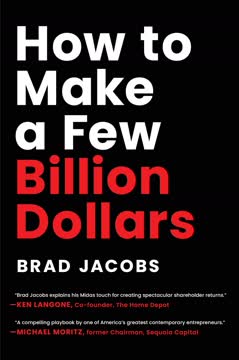اہم نکات
1. طاقت مستقل کاروباری قیمت تخلیق کرنے کی کنجی ہے
طاقت: وہ حالات جو مستقل مختلف منافع کے امکانات پیدا کرتے ہیں
طاقت قیمت کو بڑھاتی ہے۔ کاروبار میں، طاقت کا مطلب ہے کہ مسابقتی دباؤ کے باوجود مستقل، اوسط سے زیادہ منافع پیدا کرنے کی صلاحیت۔ اس میں دو عناصر شامل ہیں: ایک فائدہ جو نقد بہاؤ کو نمایاں طور پر بہتر بناتا ہے، اور ایک رکاوٹ جو حریفوں کو اس فائدے کو ختم کرنے سے روکتی ہے۔ حکمت عملی کا بنیادی مساوات اس تصور کی وضاحت کرتی ہے:
قیمت = مارکیٹ کا حجم * طاقت
جہاں:
- مارکیٹ کا حجم = موجودہ مارکیٹ کا حجم * رعایتی ترقی کا عنصر
- طاقت = طویل مدتی اوسط مارکیٹ شیئر * طویل مدتی اوسط مختلف مارجن
بغیر طاقت کے کمپنیاں ان مسابقتی قوتوں کے سامنے کمزور ہوتی ہیں جو وقت کے ساتھ منافع کو کمزور کرتی ہیں۔ انٹیل کے یاداشت چپس (بغیر طاقت) اور مائیکرو پروسیسرز (اہم طاقت) میں متضاد تجربات طویل مدتی کامیابی کے لیے طاقت کے قیام اور برقرار رکھنے کی اہمیت کو ظاہر کرتے ہیں۔
2. 7 طاقتیں: پیمانے کی معیشتیں، نیٹ ورک کی معیشتیں، مخالف پوزیشننگ، سوئچنگ کے اخراجات، برانڈنگ، کونے میں موجود وسائل، اور عمل کی طاقت
7 طاقتوں کا فریم ورک تمام دلکش حکمت عملی کی پوزیشنوں کا احاطہ کرتا ہے، یہ سادہ نہیں ہے، جبکہ اس کا یکجہتی توجہ طاقت پر اسے سیکھنے، یاد رکھنے اور کسی بھی کاروباری شخص کے لیے استعمال کرنے کے لیے کافی آسان بناتا ہے۔
7 طاقتوں کی تفہیم۔ ہر طاقت کی قسم ایک منفرد طریقہ پیش کرتی ہے تاکہ مسابقتی فائدہ پیدا کیا جا سکے اور اسے برقرار رکھا جا سکے:
- پیمانے کی معیشتیں: بڑی پیداوار کی مقدار فی یونٹ لاگت کو کم کرتی ہے
- نیٹ ورک کی معیشتیں: جیسے جیسے مزید صارفین نیٹ ورک میں شامل ہوتے ہیں، قیمت بڑھتی ہے
- مخالف پوزیشننگ: ایک نیا، اعلیٰ کاروباری ماڈل جسے موجودہ کمپنیاں آسانی سے اپنا نہیں سکتیں
- سوئچنگ کے اخراجات: صارفین کو سپلائرز تبدیل کرنے پر نمایاں اخراجات کا سامنا کرنا پڑتا ہے
- برانڈنگ: صارفین خوشی سے زیادہ قیمت کے لیے زیادہ ادائیگی کرتے ہیں
- کونے میں موجود وسائل: ایک قیمتی اثاثے تک خصوصی رسائی
- عمل کی طاقت: اعلیٰ داخلی عمل جو نقل کرنا مشکل ہیں
یہ طاقتیں باہمی طور پر خارج نہیں ہیں؛ کمپنیاں ایک ہی وقت میں متعدد اقسام کا فائدہ اٹھا سکتی ہیں۔ مثال کے طور پر، نیٹ فلکس نے پیمانے کی معیشتیں اور نیٹ ورک کی معیشتیں ملا کر اسٹریمنگ مارکیٹ میں غلبہ حاصل کیا۔
3. حکمت عملی کو اہم مارکیٹوں میں طاقت کو برقرار رکھنے کا راستہ فراہم کرنا چاہیے
حکمت عملی: اہم مارکیٹوں میں طاقت کو برقرار رکھنے کا راستہ
حکمت عملی کا منتر۔ ایک کامیاب حکمت عملی کو تین اہم تقاضے پورے کرنے چاہئیں:
- راستہ: طاقت کے قیام اور برقرار رکھنے کے لیے ایک واضح راستہ
- جاری: وقت کے ساتھ طاقت کو برقرار رکھنے کی صلاحیت
- اہم مارکیٹیں: ایسی مارکیٹوں کا ہدف بنانا جو کافی بڑی ہوں تاکہ نمایاں قیمت پیدا کی جا سکے
یہ تعریف اس بات پر زور دیتی ہے کہ حکمت عملی صرف قلیل مدتی فوائد یا عملیاتی عمدگی کے بارے میں نہیں ہے۔ بلکہ، یہ اہم ممکنات والی مارکیٹوں میں پائیدار مسابقتی فوائد پیدا کرنے پر توجہ مرکوز کرتی ہے۔ کمپنیوں کو اپنی حکمت عملی کی حیثیت کو برقرار رکھنے کے لیے اپنے کاروبار کی ترقی کے ساتھ مختلف طاقت کے ذرائع کو مسلسل اپنانا اور ان میں اضافہ کرنا چاہیے۔
کامیاب حکمت عملیوں کی مثالیں:
- ایپل کا آلات اور خدمات کا ماحولیاتی نظام
- ایمیزون کا صارف کے تجربے اور لاجسٹکس پر بے پناہ توجہ
- گوگل کی تلاش اور ڈیجیٹل اشتہارات میں غلبہ
4. اختراع طاقت کی ماں ہے اور مارکیٹ کے حجم کو بڑھاتی ہے
"'مجھے بھی' کافی نہیں ہے" طاقت کے قیام کی رہنمائی کرتا ہے۔
اختراع ترقی اور طاقت کو بڑھاتی ہے۔ طاقت کے قیام کا پہلا قدم کچھ نیا اور قیمتی تخلیق کرنا ہے۔ یہ ایک پروڈکٹ، عمل، کاروباری ماڈل، یا برانڈ ہو سکتا ہے۔ اختراع دو اہم مقاصد کی خدمت کرتی ہے:
- منفرد فوائد پیدا کرکے طاقت کے دروازے کو کھولتی ہے
- صارفین کو قائل کرنے والی قیمت پیش کرکے مارکیٹ کے حجم کو بڑھاتی ہے
قائل کرنے والی قیمت حاصل کرنے کے تین راستے ہیں:
- صلاحیتوں کی بنیاد پر: موجودہ طاقتوں کا فائدہ اٹھا کر نئے پروڈکٹس تخلیق کرنا (جیسے، ایڈوب ایکروبیٹ)
- صارف کی بنیاد پر: ایک معلوم لیکن غیر پورا شدہ صارف کی ضرورت کو حل کرنا (جیسے، کارننگ کی فائبر آپٹکس)
- حریف کی بنیاد پر: موجودہ حلوں کے مقابلے میں نمایاں طور پر بہتر متبادل پیش کرنا (جیسے، سونی پلے اسٹیشن)
کامیاب اختراعات اکثر صارفین سے "ضروری ہے" کا جواب حاصل کرتی ہیں، جو تیز اپنائیت اور مارکیٹ کی ترقی کو بڑھاتی ہیں۔ اس ابتدائی دور کی اعلیٰ تبدیلی اور عدم یقینیت طاقت کے مخصوص اقسام کے قیام کے لیے اہم ہے۔
5. طاقت کی ترقی: مختلف طاقت کی اقسام کے قیام کے لیے وقت اہم ہے
مختلف طاقت کی اقسام آپ کے کاروبار کی ترقی کے مختلف اوقات میں رکاوٹ قائم کرنے کا موقع فراہم کرتی ہیں۔
طاقت کی ترقی کا فریم ورک۔ یہ ٹول کاروباری اداروں کو سمجھنے میں مدد کرتا ہے کہ مختلف طاقت کی اقسام کب دستیاب ہوتی ہیں:
-
آغاز (پری ٹیک آف):
- مخالف پوزیشننگ
- کونے میں موجود وسائل
-
ٹیک آف (تیز ترقی):
- پیمانے کی معیشتیں
- نیٹ ورک کی معیشتیں
- سوئچنگ کے اخراجات
-
استحکام (سست ترقی):
- عمل کی طاقت
- برانڈنگ
اس ترقی کو سمجھنا صحیح وقت پر مواقع کو پہچاننے اور ان سے فائدہ اٹھانے کے لیے اہم ہے۔ مثال کے طور پر، پیمانے کی معیشتیں ٹیک آف کے مرحلے کے دوران قائم کی جانی چاہئیں جب مارکیٹ شیئر کو سازگار شرائط پر حاصل کیا جا سکتا ہے۔ اس موقع کو کھونا مستقل نقصان کا باعث بن سکتا ہے، جیسا کہ ایپل کے ایپل III کے ساتھ ذاتی کمپیوٹرز کے اہم ٹیک آف کے دوران ناکامی میں دیکھا گیا۔
6. عملیاتی عمدگی ضروری ہے لیکن مستقل کامیابی کے لیے کافی نہیں
عملیاتی عمدگی خود میں کافی نہیں ہے۔
عملیاتی عمدگی سے آگے۔ اگرچہ روزمرہ کی کامیابی کے لیے اہم ہے، عملیاتی عمدگی اکیلے طویل مدتی منافع کی ضمانت نہیں دیتی۔ اس کی وجہ یہ ہے کہ آپریشنز میں بہتری اکثر حریفوں کی جانب سے نقل کی جا سکتی ہے، جس کے نتیجے میں صنعت بھر میں اپنائیت اور عارضی فوائد کا زوال ہوتا ہے۔
اہم تفریق:
- عملیاتی عمدگی: موجودہ عملوں اور مصنوعات کو مسلسل بہتر بنانا
- حکمت عملی کا فائدہ: طاقت پیدا کرنا اور برقرار رکھنا جو مسابقتی منافع کو روکتا ہے
تاہم، تیز تبدیلی کی صورتوں میں جیسے کہ ٹیک آف کا مرحلہ، عمدہ عمل درآمد انتہائی حکمت عملی ہو سکتا ہے۔ انٹیل کی آپریشن کرش، جس نے آئی بی ایم پی سی کے معاہدے کو محفوظ کیا، یہ ظاہر کرتی ہے کہ عملیاتی عمدگی طویل مدتی طاقت کے قیام میں فیصلہ کن ہو سکتی ہے۔
وہ شعبے جہاں عملیاتی عمدگی اہم ہے لیکن کافی نہیں:
- مصنوعات کے معیار میں بہتری
- لاگت میں کمی کے اقدامات
- صارف کی خدمت میں بہتری
- سپلائی چین کی اصلاحات
7. قیادت طاقت کے قیام اور تیز تبدیلی کی صورتوں میں نیویگیشن میں اہم کردار ادا کرتی ہے
سٹیٹکس سے ڈائنامکس کی طرف بڑھتے ہوئے، دائرہ کار میں کافی اضافہ ہوتا ہے۔
متحرک ماحول میں قیادت۔ اگرچہ اچھی انتظامیہ مستحکم مارکیٹوں میں طاقت کی کمی پر قابو نہیں پا سکتی، قیادت تیز تبدیلی کے ادوار میں طاقت کے قیام میں بنیادی حیثیت رکھتی ہے۔ رہنماؤں کو چاہیے کہ:
- طاقت کے ابھرتے ہوئے مواقع کو پہچانیں
- غیر یقینی ماحول میں جرات مندانہ فیصلے کریں
- اہم ادوار کے دوران مؤثر طریقے سے عمل درآمد کے لیے تنظیم کو متحرک کریں
اہم قیادت کے لمحات کی مثالیں:
- انٹیل میں باب نائس کا مائیکرو پروسیسرز کی طرف بڑھنے کا فیصلہ
- اینڈی گروو کا آئی بی ایم پی سی کے معاہدے کو محفوظ کرنے کے لیے جارحانہ آپریشن کرش
- نیٹ فلکس میں ریڈ ہیسٹنگز کا اسٹریمنگ اور اصل مواد کی طرف منتقل ہونا
ان متحرک صورتوں میں، رہنماؤں کو طویل عرصے تک ذہین ایڈاپٹیشن کے ذریعے حکمت عملی تیار کرنی چاہیے، جس کا سامنا خوفناک عدم یقینیت سے ہوتا ہے۔ یہ عمل منصوبہ بندی کے بجائے کاروباری روح کے زیادہ قریب ہے، جس میں 7 طاقتوں کی گہری تفہیم اور طاقت کے قیام کے لیے عارضی مواقع کو پہچاننے اور ان سے فائدہ اٹھانے کی صلاحیت کی ضرورت ہوتی ہے۔
آخری تازہ کاری:
FAQ
What's "7 Powers: The Foundations of Business Strategy" about?
- Overview of the book: "7 Powers" by Hamilton Wright Helmer is a comprehensive guide to understanding the fundamental determinants of business strategy and value creation.
- Core concept: The book introduces the concept of "Power," which refers to the conditions that create the potential for persistent differential returns in business.
- Framework: Helmer outlines seven types of strategic power that businesses can leverage to gain a competitive advantage.
- Purpose: The book aims to provide a practical framework for business leaders to identify, create, and maintain strategic advantages in their industries.
Why should I read "7 Powers: The Foundations of Business Strategy"?
- Strategic insights: The book offers deep insights into the nature of competitive advantage and how it can be achieved and sustained.
- Practical application: Helmer provides actionable strategies that can be applied to real-world business scenarios, making it valuable for business leaders and strategists.
- Comprehensive framework: The seven powers framework is a unique and comprehensive approach to understanding business strategy.
- Expert endorsements: The book is praised by industry leaders like Reed Hastings and Daniel Ek, highlighting its relevance and impact.
What are the key takeaways of "7 Powers: The Foundations of Business Strategy"?
- Power is essential: The book emphasizes that having at least one of the seven powers is crucial for a business to achieve sustainable competitive advantage.
- Invention is key: Invention is the first step towards creating power, whether through products, processes, or business models.
- Timing matters: The book outlines the importance of timing in establishing power, particularly during the takeoff stage of a business.
- Strategic focus: Businesses must focus on creating compelling value and identifying opportunities for power to succeed in the long term.
What are the seven powers outlined in "7 Powers: The Foundations of Business Strategy"?
- Scale Economies: Achieving lower per-unit costs with increased production volume.
- Network Economies: Increasing the value of a product as more people use it.
- Counter-Positioning: Adopting a superior business model that incumbents cannot mimic without damaging their existing business.
- Switching Costs: Creating value loss for customers who switch to a competitor.
- Branding: Building a durable attribution of higher value to a product through historical information about the seller.
- Cornered Resource: Gaining preferential access to a coveted asset that enhances value.
- Process Power: Developing complex processes that competitors cannot easily replicate.
How does Hamilton Helmer define "Power" in "7 Powers: The Foundations of Business Strategy"?
- Definition: Power is defined as the set of conditions creating the potential for persistent differential returns.
- Components: It requires both a benefit, which improves cash flow, and a barrier, which prevents competitors from arbitraging away the benefit.
- Strategic importance: Power is the core concept of strategy and is essential for creating business value.
- Long-term focus: The book emphasizes that power must be sustainable to ensure long-term competitive advantage.
What is the "Fundamental Equation of Strategy" in "7 Powers: The Foundations of Business Strategy"?
- Equation: The equation is NPV = M0 g s m, where NPV is the net present value of expected future free cash flow.
- Components: M0 represents current market size, g is the discounted market growth factor, s is long-term market share, and m is long-term differential margin.
- Purpose: This equation links strategy to business value by quantifying the impact of market size and power.
- Strategic focus: It highlights the importance of both market scale and power in determining business value.
How does "7 Powers: The Foundations of Business Strategy" address the role of invention in strategy?
- Invention as a starting point: The book emphasizes that all power starts with invention, whether in products, processes, or business models.
- Creating value: Invention is crucial for creating compelling value that drives market size and opens opportunities for power.
- Strategic differentiation: "Me too" strategies won't suffice; businesses must innovate to achieve a competitive edge.
- Guidance for leaders: The book provides a framework for leaders to identify and leverage invention to establish power.
What is the "Power Progression" in "7 Powers: The Foundations of Business Strategy"?
- Concept: The Power Progression maps when power must be established by power type, indicating the timing of strategic opportunities.
- Stages: It divides the business lifecycle into origination, takeoff, and stability stages, each with different power opportunities.
- Strategic timing: The progression helps businesses understand when to focus on different types of power to maximize value.
- Practical application: It serves as a guide for leaders to align their strategic efforts with the right timing for power establishment.
What are some of the best quotes from "7 Powers: The Foundations of Business Strategy" and what do they mean?
- "Making a small number of decisions wisely is far more important than making a lot of decisions correctly." This quote emphasizes the importance of strategic focus and prioritization in business decision-making.
- "If you don’t get your strategy right, you are at risk." This highlights the critical role of strategy in ensuring business success and sustainability.
- "Strategy serves best not as an analytical redoubt, but rather in developing the 'prepared mind' of those on the ground." This underscores the practical application of strategy in real-world business scenarios.
- "The first cause of a strategy is invention." This quote stresses the importance of innovation as the foundation of strategic advantage.
How does "7 Powers: The Foundations of Business Strategy" differentiate between Strategy Statics and Strategy Dynamics?
- Strategy Statics: Focuses on understanding strategic position at a single point in time, emphasizing the importance of power.
- Strategy Dynamics: Explores the development of strategy over time, addressing how businesses can establish power.
- Complementary perspectives: Both statics and dynamics are essential for a comprehensive understanding of business strategy.
- Practical application: The book provides insights into how businesses can navigate both static and dynamic aspects of strategy to achieve success.
How can "7 Powers: The Foundations of Business Strategy" be applied to real-world business scenarios?
- Framework for analysis: The seven powers framework can be used to analyze and assess a company's strategic position and opportunities.
- Guidance for leaders: Business leaders can use the book's insights to identify and create strategic advantages in their industries.
- Practical strategies: The book offers actionable strategies for leveraging power to achieve competitive advantage and business value.
- Case studies: Real-world examples and case studies in the book illustrate how the concepts can be applied in practice.
What is the significance of the "7 Powers" framework in "7 Powers: The Foundations of Business Strategy"?
- Comprehensive approach: The framework provides a comprehensive approach to understanding and achieving strategic advantage.
- Exhaustive coverage: It covers all attractive strategic positions for businesses, ensuring no viable strategy is overlooked.
- Practical tool: The framework serves as a practical tool for business leaders to navigate complex strategic landscapes.
- Enduring relevance: The seven powers are applicable to businesses across industries and stages, making the framework enduringly relevant.
جائزے
7 پاورز کو مختلف آراء ملتی ہیں، جن کی درجہ بندیاں 2 سے 5 ستاروں تک ہیں۔ بہت سے قارئین اس کی مختصر کاروباری حکمت عملی کے فریم ورک کی تعریف کرتے ہیں، اور اس کی عملی اطلاق اور حقیقی دنیا کی مثالوں کو اجاگر کرتے ہیں۔ ناقدین کا کہنا ہے کہ مواد انقلابی نہیں ہے اور موجودہ تصورات پر بہت زیادہ انحصار کرتا ہے۔ کچھ لوگ ریاضیاتی نقطہ نظر کی تعریف کرتے ہیں، جبکہ دیگر اسے غیر ضروری سمجھتے ہیں۔ کتاب کی سات اہم اسٹریٹجک پوزیشنز (پاورز) پر توجہ عام طور پر مثبت طور پر لی جاتی ہے، حالانکہ کچھ قارئین مزید گہرائی اور کیس اسٹڈیز کی خواہش کرتے ہیں۔ مجموعی طور پر، یہ کاروباری حکمت عملی میں دلچسپی رکھنے والوں کے لیے ایک قیمتی وسیلہ سمجھا جاتا ہے۔
Similar Books














